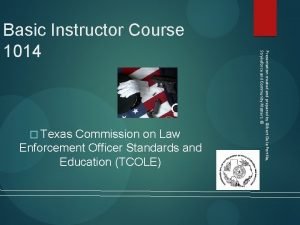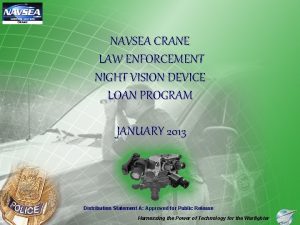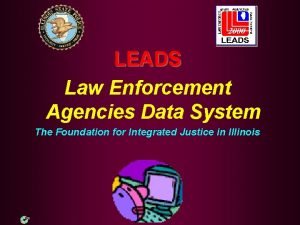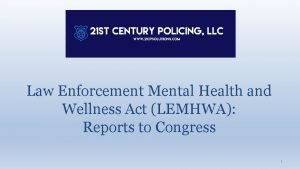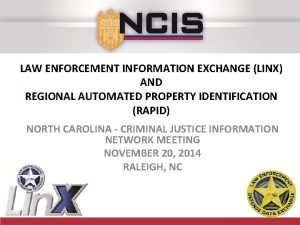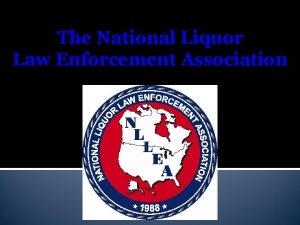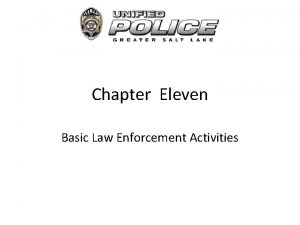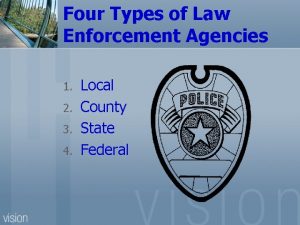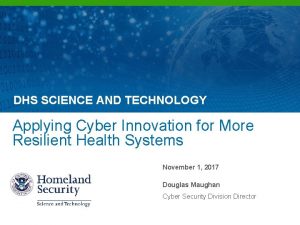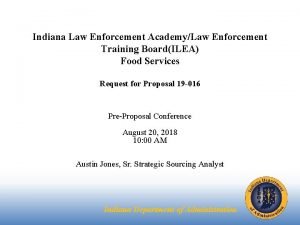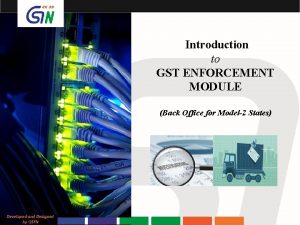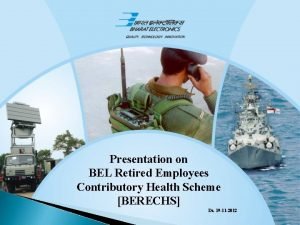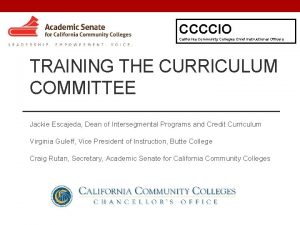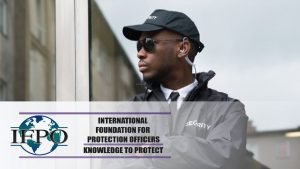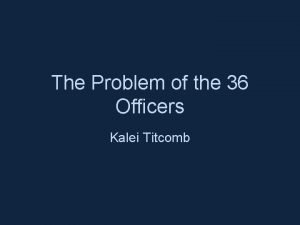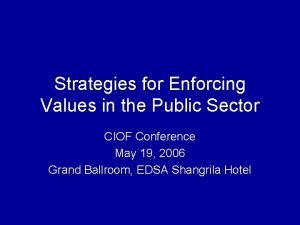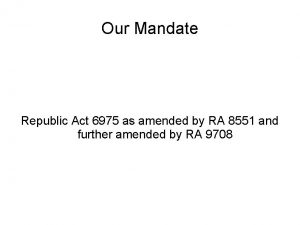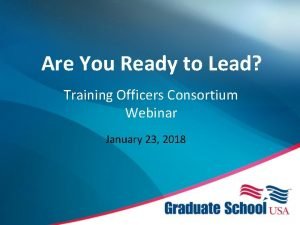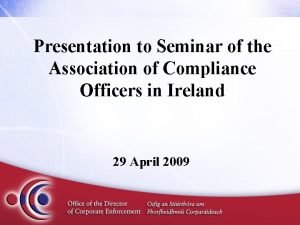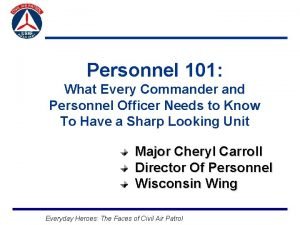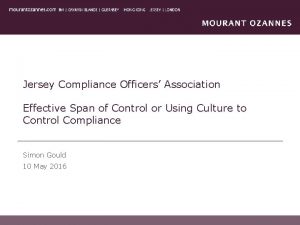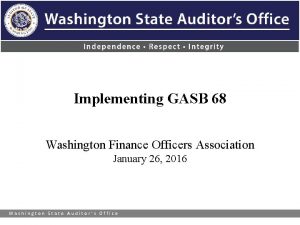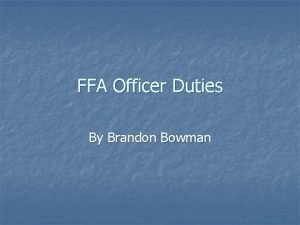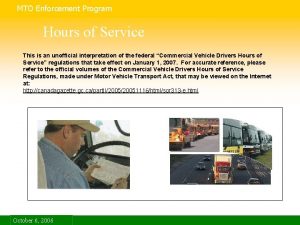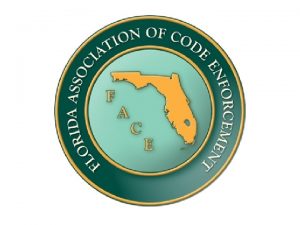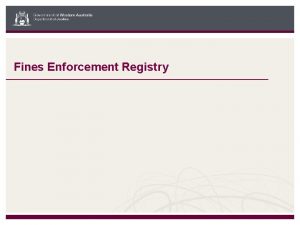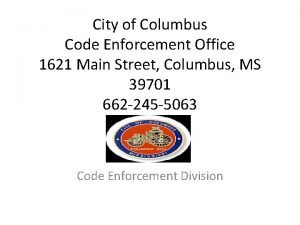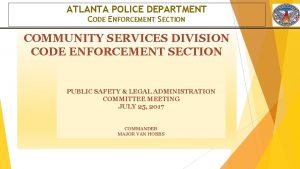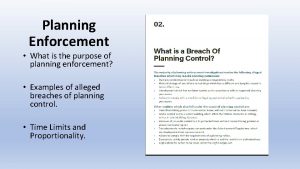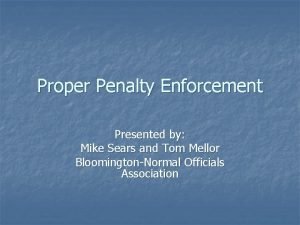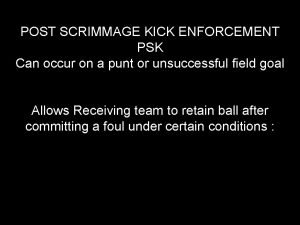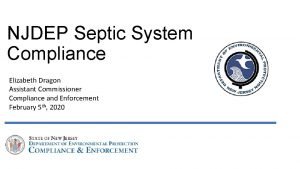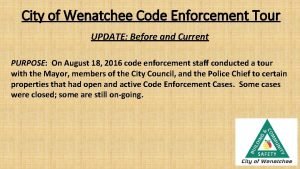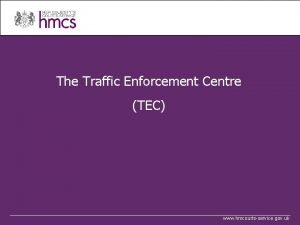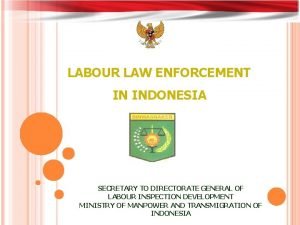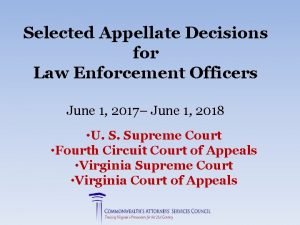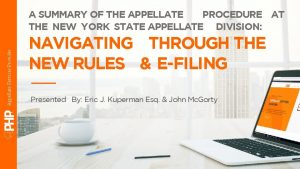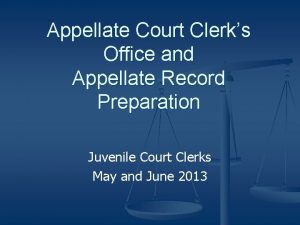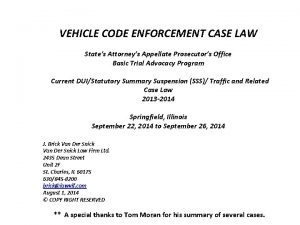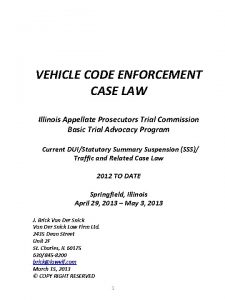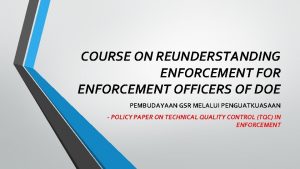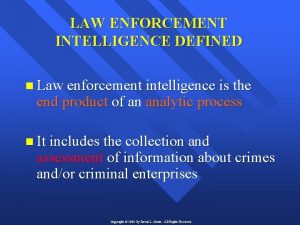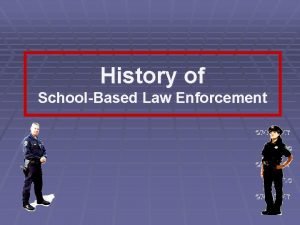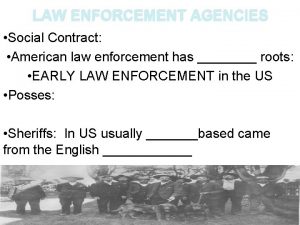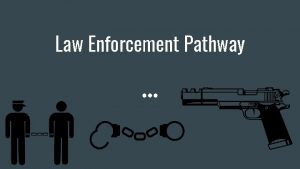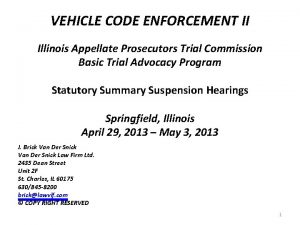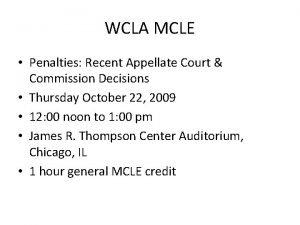Selected Appellate Decisions for Law Enforcement Officers June















































































































- Slides: 111

Selected Appellate Decisions for Law Enforcement Officers June 1, 2017– June 1, 2018 • U. S. Supreme Court • Fourth Circuit Court of Appeals • Virginia Supreme Court • Virginia Court of Appeals

Please refer to 2018 Appellate Update Master List for a complete listing of new cases of interest to law enforcement officers.

Topics for Presentation • Fourth Amendment • Fifth Amendment • Crimes Against Persons • Crimes Against Property • Drug & Gun Offenses • DUI and Traffic Offenses • Evidentiary Issues

New Cases on Interviews & Interrogations FIFTH AMENDMENT

Coercion: U. S. v. Giddins • Police seized defendant’s car during bank robbery investigation. • Defendant visits police station to get his car back. • The officers told him that he was free to go, but that they had some questions for him. • The defendant asked if he was “in trouble”, but the police told him that he was not and they were only asking about the car’s involvement in the offenses.

Police Obtain Miranda Waiver • The officers asked the defendant to sign a Miranda waiver. • The defendant asked if this was the procedure to get his car back, as the car was essential to his livelihood. • The officers told him: “Yeah—in order for us to ask you questions, because the vehicle was used in a crime, by law, we have to go over these rights… Before I release the car to you, I would like to know some answers. . . I would like to know some answers before we release your car back to you. ”

Court: Evidence Suppressed • A reasonable person would have felt unable to cease the interview and thus forfeit the opportunity to obtain the return of the vehicle. • Police affirmatively deceived the defendant to obtain his Miranda waiver by failing to inform him that he was the subject of the investigation when he asked whether he was “in trouble”, which added to the compulsion. – U. S. v. Giddins, 858 F. 3 d 870 (2017)

Granado: DUI Investigation • Two officers approached a car stopped on the road, and ordered the driver to show his hands. • Defendant repeatedly refused to show his hands • The officers drew their weapons, forcibly removed him from the car, and handcuffed him until they could determine whether he had any weapons. • From then on, the officers did not use threatening language. • The officers did not tell the defendant that he was under arrest, nor did they put him in a police car.

Held: Statements Admissible • The Court ruled the defendant was not in custody for purposes of Miranda and that the officers merely put him in investigative detention. • The Court distinguished the Dixon and Hasan cases, finding that a reasonable person would not have believed that he was under arrest at the time that he made statements. • Drawing weapons, handcuffing a suspect, placing a suspect in a patrol car for questioning, or using or threatening to use force does not necessarily elevate a lawful stop into custody. – Granado v. Commonwealth, December 5, 2017 (Unpub)

Diggs: Non-Police Custody • Defendant was a patient at a secure mental health treatment facility due to a recent suicide attempt. • The defendant was hydrocephalic, has a 9 th-grade education, and suffered from emotional and psychiatric problems. • An officer investigating a sexual assault interviewed the defendant at the facility. The officer did not read Miranda warnings. The officer told the defendant that he was not under arrest and made clear that he was free to leave.

Held: Statements Admissible • Court: The question is whether police subjected him to “a formal arrest or restraint on freedom of movement of the degree associated with formal arrest. ” • In this case, the Court ruled that the interview by a single officer in a neutral setting was not a custodial interrogation and therefore did not require Miranda warnings. – Diggs v. Commonwealth, Unpublished (January 30, 2018)

New Cases on Search & Seizure FOURTH AMENDMENT

Cars and Curtilages • Officer saw a motorcycle under a tarp in a driveway and had probable cause to believe it was stolen. • Officer walked up the driveway, past the path to the front door, and lifted the tarp, confirming it was the stolen motorcycle. • Virginia Supreme Court found search lawful under the Carroll doctrine – finding that searching a car does not require a warrant if the officer has probable cause.

U. S. Supreme Court: Carroll does not apply in Curtilage • Court: The automobile exception to the 4 th Amendment does not permit a police officer, uninvited and without a warrant, to enter the curtilage of a home in order to search a vehicle parked therein. • The Court likened this case to a situation where an officer sees contraband inside a home through a window, which would also require a warrant. • Collins v. Virginia, May 29, 2018

Byrd: Rental Cars • Defendant’s girlfriend rented a car and allowed him to drive it, even though he was not an authorized driver and allowing him to do so violated the rental agreement • Police stopped the car and found drugs. • The trial court and appeals court concluded that, because the defendant was not listed on the rental agreement, he lacked a reasonable expectation of privacy in the car.

U. S. Supreme Court: Reversed • Court: As a general rule, someone in otherwise lawful possession and control of a rental car has a reasonable expectation of privacy in it, even if the rental agreement does not list him or her as an authorized driver. • The real question is whether the defendant lawfully possessed the car from the girlfriend.

Note: This Case is Not Over • The Court qualified that the defendant’s “wrongful” presence in the vehicle would not enable him to object to the legality of the search. • If the defendant had obtained the vehicle by theft or subterfuge, he may not be entitled to raise a Fourth Amendment claim. • Court remanded the case to determine if he used fraudulent means to obtain the car.

Suspicion of DUI: Slentz • Slentz v. Commonwealth, Unpublished (December 12, 2017) • An officer watched the defendant’s vehicle twice cross the white fog line of the roadway and briefly drive onto the grass shoulder. • The officer stopped the defendant and learned he was intoxicated.

Court: Stop Lawful • Court: defendant violated Code § 46. 2 -804(2) by weaving over the fog line and onto the shoulder of the road, even if the actions were brief. • The Court pointed out that, while the defendant may very well have had an explanation for his actions or could have provided a basis for the officer to conclude that it was not “practicable” to stay within the lane of travel when the vehicle briefly crossed the fog line onto the shoulder, such explanations did not negate objective reasonable suspicion.

Tag Lights: Lewis • From a distance of between fifty feet and fifty yards away, an officer saw defendant’s car had two lights that were intended to illuminate the license plate. • Only the left light was lit and the right light was not functioning. • The officer was nevertheless able to read the license plate.

Court: Stop Lawful • Court: Officer had reasonable suspicion. • The Court pointed out that the fact that the license plate was visible from fifty feet did not mean there was no defect in the lights illuminating the license plate. • Applying the “defective equipment” code section, § 46. 2 -1003, the Court reasoned that if both lights illuminating the license plate are not operational, the equipment is defective, “no matter how minimal. ” – Lewis v. Commonwealth, Unpublished (October 31, 2017 )

Search Warrants: Inferences • After arresting defendant in a car with a distribution amount of drugs and a gun, an officer obtained a warrant for the defendant’s home. • In the warrant, the officer detailed that the defendant had been the victim of an attempted robbery at his residence the week before and that an informant had repeatedly seen the defendant with large quantities of drugs and money. • The officer detailed why the facts indicated that the defendant’s residence was the “base of operations” for his drug distribution.

Court: Warrant Lawful • “The magistrate need not determine that the evidence sought is, in fact, on the premises to be searched or that the evidence is more likely than not to be found where the search is to take place. The magistrate need only conclude that it would be reasonable to seek the evidence in the place indicated in the affidavit. ” • The officer “only needed to state objective facts that would enable a magistrate to find that a ‘fair probability’ existed that evidence of drug distribution would be found in the home. ” – Brown v. Commonwealth, Published (March 20, 2018)

Invasive Search: Sims v. Labowitz • 4 th Circuit, March 2018 • 17 -year-old defendant sexually-explicit photos and videos of himself to his 15 -year-old girlfriend • Detective obtained a search warrant for: “Photographs of the genitals, and other parts of the body of [Sims] that will be used as comparisons in recovered forensic evidence from the victim and suspect’s electronic devices. This includes a photograph of the suspect’s erect penis. ”

Court: Search Unlawful • Detective asked the defendant to pull down his pants and, according to the plaintiff, told him “to use his hand to manipulate his penis in different ways” to obtain an erection. • Court: The search warrant authorized the search. • BUT the Court found that the search was sexuallyinvasive and therefore also must be “reasonable. ” • The Court found the scope of the search was “outrageous, ” the manner was intimidating, and that there was no evidentiary need to seek a photograph of the plaintiff’s erect penis.

Jail Searches: Cole • Officer arrested defendant for drug offense. • Officer brought the defendant to jail, where the policy was to strip-search all drug arrestees. • Jail officers discovered that the defendant carried cocaine in his anus. • Trial court suppressed the search as unlawful because it lacked any basis.

Court: • Held: The jail’s policy was reasonable and the search was proper. • The legitimate concerns that a jail has in its booking area, such as the dangers of disease, gang-based violence, and the disruption of jail safety due to an underground economy trading in contraband are heightened in drug cases. – Cole v. Commonwealth, 294 Va. 342 (2017)

Campbell: Exigent Circumstances • Officers observed a live “meth cook” in a shed from a concealed location. • Officers executed a search warrant, but the warrant had a defect. • Officers later testified about the highly toxic nature of the chemicals employed in the process and the grave danger that exposure to meth-related substances can present. They also explained the serious risk of fire or explosion.

Held: Warrantless Search Lawful • Court: Regardless of the warrant’s defect, the search was lawful under “exigent circumstances, ” based on the dangers and the risk to both safety and of destruction of evidence. • The Court reasoned that, even if the police had not obtained a warrant under the circumstances, and had instead assembled the law enforcement team and raced to the scene of the “meth cook” that was either on the cusp of, or actually was, taking place, such a warrantless search would be justified – Campbell v. Commonwealth, 294 Va. 486 (2017)

DUI: Exigent Circumstances • Defendant, driving drunk, caused a crash that crippled another driver and killed her own child. • At the scene, the defendant tried to hide beer cans and told a witness not to call 911. • After a helicopter transported the defendant and her child to the hospital, an officer learned alcohol may have been involved and rushed to the hospital. • More than three hours after the crash, the officer took defendant’s blood without a warrant.

Court: Exigency Justified Draw • Court relied on the delay in drawing blood, the length of time that passed after the crash, and the defendant’s efforts to conceal evidence. • The Court pointed out that, even under Mc. Neely, the detrimental effects of the passage of time upon the reliability of a blood test may alone sometimes be sufficient to justify a warrantless, nonconsensual blood draw. – Aponte v. Commonwealth, 68 Va. App. 146 (2017)

Length of Stop: Rivera • Officer called for a K-9 during a stop for a traffic violation, though he had no evidence of a drug offense. • After completing the summons, instead of delivering the summons to the defendant and obtaining his signature, the officer explained that a dog was going to walk around the car and patted the defendant down. Dog alerted. • Court: Evidence Suppressed. • The Court ruled that the police investigation unlawfully extended the stop, however briefly, and thus violated the 4 th Amendment.

Court: Basic Safety Measures Still Permissible • The Court agreed that, even under Rodriguez v. U. S. , a police officer’s safety interest stems from the mission of the stop itself and therefore, an officer may take precautions in order to complete his mission safely. • The Court found that the officer did not violate Rodgriguez when conferred briefly with the other police officers to learn more about the defendant’s criminal history before re-approaching him, as it was in accordance with maintaining officer safety during the stop. – Commonwealth v. Rivera, Unpublished, January 30, (2018)

LPRs – Not 4 th Amendment, but ”Data Act” Issue • Plaintiff sued to stop the Fairfax County Police Department from using automated license plate readers (“ALPRs) to maintain a database regarding passively-recorded plates that officers could search by license plate number. • Plaintiff argued that the ALPRs violate the Virginia Government Data Collection and Dissemination Practices Act, §§ 2. 2 -3800 to -3809, including the requirement in § 2. 2 -3800(C)(2) that information not be collected “unless the need for it has been clearly established in advance” of collecting that information.

Court: The Data Act covers LPRs • Court: A license plate number stored in the ALPR database is NOT “personal information” because it does not describe, locate or index anything about an individual. • The pictures and associated data stored in the ALPR database DO meet the statutory definition of “personal information” under § 2. 2 -3801. • The Court remanded the case to determine whether the total components and operations of the ALPR record-keeping process provide a means through which a link between a license plate number and the vehicle’s owner “may be readily made. ”

Court: Passive ALPRs may violate the Data Act • The Court stated that, if such a means exists, then the police department’s “passive use” of ALPRs is not exempt from the operation of the Data Act under the law enforcement exception of § 2. 23802(7), because the police department collected and retained personal information without any suspicion of criminal activity at any level of abstraction, and thus created an information system that does not “deal with investigations and intelligence gathering related to criminal activity. ” – Neal v. Fairfax Police, April 26, 2018 (Va. S. Ct. )

Note: ACTIVE LPRs Were Not an Issue Here • This case did not concern the “active” use of ALPRs, to search for a particular license plate at a particular time • In a footnote, the Court made clear that the phrase “investigations and intelligence gathering related to criminal activity, ” as used in § 2. 2 -3802(7), is not necessarily limited to past or present criminal activity to the exclusion of future criminal activity, as the Fourth Amendment does not make that distinction.

PART TWO: CRIMES AND OFFENSES

CHILD ABUSE & NEGLECT

Many Cases This Year • There were an unusual number of cases this year from the courts of appeal regarding the various statutes that address child abuse & neglect. • In the following slides, Nancy Oglesby from CASC profiled these cases and some lessons from them

18. 2 -371. 1: Statute A. Any parent, guardian, or other person responsible for the care of a child under the age of 18 who by willful act or willful omission or refusal to provide any necessary care for the child’s health causes or permits serious injury to the life or health of such child is guilty of a Class 4 felony. B. Any parent, guardian or other person responsible for the care of a child under the age of 18 whose willful act or omission in the care of such child was so gross, wanton, and culpable as to show a reckless disregard for human life is guilty of a Class 6 felony.

18. 2 -371. 1 (A) versus (B): Any parent, guardian, or other person responsible for the care of a child under the age of 18: Subsection (A): • who by willful act or omission or refusal to provide any necessary care for the child’s health • causes or permits serious injury to the life or health of such child. Subsection (B): • whose willful act or willful omission in the care of such child • was so gross, wanton, and culpable to show a reckless disregard for human life.

18. 2 -371. 1(A) and (B) • Turner v. Commonwealth, Record No. 006716 -1 (January 2017) • Affirmed conviction for 18. 2 -371. 1(A) and (B) when defendant crashed and killed one of her children and seriously injured another. • Court: Her conduct was willful; she had knowledge and consciousness of the risk and commented “F* the cops. ” • Her acts of speeding, marijuana use, and not providing seat belts or child seats for her children sufficiently demonstrated her guilt.

18. 2 -371. 1 (B) • Coomer v. Commonwealth, 67 Va. App. 537 (March 2017) • Reversed a conviction for defendant who crashed her car while driving with a. 09 and her child in the car during rainy conditions. • Court: No “Criminal Negligence” because of her low speed and no damage to either car. • No “Criminal Negligence” with mere voluntary intoxication (“not severely impaired”). • Court: The danger must reach a level of probability/substantial risk, not mere possibility.

18. 2 -371. 1 (A) • Thompson v. Commonwealth, Record No. 0842 -16 -2 (Unpublished, August 2017) • Reversed conviction after defendant provided no medical attention to her two year old, who had severely burned feet (evidence was burn was accidental). • Medical testimony spoke to potential harm from delay. • Court: Omission of seeking medical attention did not cause serious injury (or any injury) over and above the burns – testimony was only that infection could have resulted. • Remember this prosecution was under (A), not (B).

18. 2 -371. 1 (B) • Hannon v. Commonwealth, 68 Va. App. 87 (2017) • Reversed conviction for defendant who left 4 month old and 5 year old in unlocked car in 48 degree weather for 14 minutes & 34 seconds • CPS had unfounded the complaint • Court: A reasonable person would not have understood injury was likely to occur • Note the comparison to Miller, where the Court had affirmed a misdemeanor conviction in similar circumstances.

18. 2 -371. 1(A) • White v. Commonwealth, Record No. 0654 -16 -3 (Unpublished, August 2017) • Court reversed conviction regarding defendant’s 5 year-old child, whose body was found in septic tank on property • Court: “Willful” is stronger than voluntary or intentional – equivalent of malicious, evil or corrupt. – Imports knowledge and consciousness that injury will result from the act done.

White Court’s Explanation • Under (A), the Act/Omission must be intentional, or involve reckless disregard for rights of another, and the Commonwealth must show that it was likely to result in serious injury • In this case, though defendant knew her son might go outside while she was sleeping, the mere presence of potential hazards in the yard (pool, pond, septic tank) was not sufficient to show knowledge of likelihood of serious injury

18. 2 -371. 1 (B) • Gibbs v. Commonwealth, Record No. 1020 -17 -2 (Unpub. , April 2017) • Affirmed conviction for defendant whose 5 year-old was found wandering around apartment complex in February and ran across busy street to Costco parking lot – past a pool, pond and privacy fence • After 40 -45 minutes, the defendant returned to the apartment, but was not concerned, even though he knew of prior incident where child had wandered out and gone to the apartment complex pool in January • Defendant had been at the child’s school over conference for behavioral issues/ referrals

• Court applied 6 factors from Barnes v. Commonwealth (47 Va. App. 105) applying 40. 1 -103: 1. The gravity and character of the possible risks of harm (busy street – Costco gas station) 2. The degree of accessibility of the parent (completely absent) 3. The length of time of the abandonment (15 min not enough, but 45 min was enough with other factors) 4. The age and maturity of the children (5 y. o. unruly, discipline issues, previous behavior) 5. The protective measures, if any, taken by the parent (none); and 6. Any other circumstance that would inform the fact finder on the question whether the defendant’s conduct was criminally negligent. • Court: Most significant fact was the defendant’s awareness that prior incident occurred

18. 2 -371. 1(B) • Camp v. Commonwealth, Record No. 0483 -17 -2 (Published, May 2018) • Affirmed conviction for defendant who drove with a. 25 BAC on two flat tires • Court: Driving with a BAC far above the legal standard for DUI can be sufficient to allow a rational factfinder to conclude that the risk of injury is probable. • Defendant’s BAC and the forensic toxicologist’s testimony regarding the effects of such level of intoxication constituted sufficient evidence.

Lessons Regarding 371. 1(A) • What is Enough to Prove a Violation: – Speed, No Car Seats, Marijuana Use, Evidence of Knowledge of Illegality • What is NOT Enough to Prove a Violation: – Failure to seek medical attention where no subsequent serious injury occurs – Failure to supervise small child without specific knowledge of risk that is likely to cause injury

Lessons Regarding 371. 1(B) • What is NOT Enough to Prove a Violation: – Voluntary intoxication (. 09) and driving – not criminal negligence – Leaving kids unattended in a car – 14 minutes • What is Enough to Prove a Violation: – Driving with a. 25 BAC – Leaving 5 y. o. alone for 45 minutes – with history of same propensity to “wander” and unruly, bad behavior history – but – “We certainly create no per se rule that a parent who leaves a five-year-old child at home by himself will be guilty of felony child neglect “

Important Language from Cases • “policy determinations underlying the statutory classifications have been made by the General Assembly” • “this statute (18. 2 -36. 1) would have been wholly unnecessary if the GA believed that driving under the influence, standing alone, was sufficient to establish criminal negligence. ” • “does not impose criminal liability on parents who fail to take positive action to ferret out every potential hazard…” • “we do not endorse or condone her parenting choices” • “we do not punish appalling parenting” • “to affirm this conviction would be to hold that 18. 2 -371. 1 requires a parent to search out potential dangers and continuously supervise his or her child.

CHILD SOLICITATION

Internet Solicitation • Defendant, a school teacher, sent sexually suggestive texts to 11 -year-old boy in her class. • Defendant sent pictures of herself in the bathtub, including a photo of the upper portion of her breasts, asking the child if he had ever seen a woman’s “boobs” before. She also sent a picture of her lips making a kiss. • The defendant asked the child to delete the photos and hide her contact information from his parents. • She inquired as to where she could be alone with the child in order that she could kiss him, but cautioned that if they were alone, she would do “so many dirty things” with the child.

Court: Conviction Affirmed • Court: Defendant need not have actually committed the crime of taking indecent liberties with a child under § 18. 2 -370 to have committed the crime of engaging in improper communications involving a child under § 18. 2 -374. 3(B). • It was sufficient that the defendant’s communication was “for the purpose of moving forward with a scheme of taking indecent liberties with a child. ” – Contrast with Murgia, from May 2017 Ct. App. , where “words alone” were not enough for a conviction • Dietz v. Commonwealth, 294 Va. 123 (2017)

CHILD PORNOGRAPHY

Proving Knowing Possession • Defendant found with child pornography on his computer. • Defendant admitted that the computer belonged to him, only he had access to it, that he had installed “Shareaza” software, and that he secured the computer with a username and password. • Forensic expert testified that he found “orphan” images of child pornography in a part of the computer that retained deleted data. The computer’s user would not have been able to access or recover those images from unallocated space without using special software.

Court: Conviction Affirmed • The orphan images retained associated dates and times indicating when they were first stored on the computer; the dates were within a few weeks of date alleged in the indictment. • Court: Commonwealth is not required to prove the exact date that the defendant possessed the images, because time is not a material element of the offense. • Court: the “orphan” images were subject to the defendant’s dominion and control from their download dates until he acted to delete them. – Christy v. Commonwealth, Unpublished (April 10, 2018)

CREDIT CARD THEFT

Caregiver Fraud • Defendant was caregiver for victim, who had a serious brain injury due to West Nile virus and encephalitis. • Victim was chronically forgetful, often became confused, and could not process basic information such as the date, time, or season. She was unable to take care of herself. • Defendant’s job required her to use the victim’s debit card while taking her shopping because the victim often could not remember her PIN number and often dropped or forgot to put her debit card back in her purse. She had to put the card back into victim’s purse immediately after each transaction.

Defendant Steals from Victim • ATM video surveillance revealed that the defendant used the victim’s card to make two cash withdrawals for $300 each without the victim being present. • When her employer confronted her, the defendant claimed that one of her co-workers had dressed up like her and “was trying to get her in trouble. ” • At trial, the defendant argued that the Commonwealth failed to show that the victim was “mentally incapacitated” and failed to prove that the defendant used the card without the victim’s consent.

Court: Conviction for Credit Card Fraud Affirmed • Court: It was reasonable to conclude that the victim did not consent to the defendant’s possession of her debit card when the defendant withdrew funds from the bank account. • Defendant’s sole possession of the card was not authorized as part of her employment and that the defendant immediately attempted to shift the blame when confronted. • No evidence supported the defendant’s hypothesis of innocence that the victim consented to her possession and use of the card at the ATMs.

Court: Conviction for Financial Exploitation Affirmed • 18. 2 -178. 1 defines “mental incapacity” as a “condition of a person existing at the time of the offense described in subsection A that prevents [her] from understanding the nature or consequences of the transaction or disposition of money or other thing of value involved in such offense. ” • Court: The evidence was sufficient to prove that the victim’s condition at the time of the offense precluded her from understanding the nature and consequences of the defendant’s withdrawals of cash at ATMs from her account. – White v. Commonwealth, 68 Va. App. 241 (2017)

DRIVING SUSPENDED OR REVOKED

No O. L. versus Driving Suspended • Court: § 46. 2 -301(B) prohibits anyone whose license has been suspended or revoked from driving on the highways of the Commonwealth while a suspension or revocation is in effect, unless they obtain a restricted license. • That applies even if a person would normally be exempt from the requirement to obtain a driver’s license. – Grasty v. Commonwealth, Unpublished (Dec. 2017)

DUI

Proof of Intoxication • Defendant crashed into another car while driving intoxicated. • Defendant admitted to driving, seemed unsteady on his feet, and had glassy eyes and slurred speech. The defendant failed all field sobriety tests. • Defendant admitted to the officer that he took Valium, Percocet, and Neurontin before the crash. • Toxicologist explained how those drugs affect a person.

Court: Conviction Affirmed • Court: the evidence, even without the certificate of analysis, was sufficient to prove that the defendant was driving under the influence. • The officer observed that the defendant exhibited the exact side effects that the toxicologist testified the drugs that the defendant admitted taking would have. – Hicks v. Commonwealth, Unpublished (August 2017)

Refusal to Perform FSTs • Defendant made an illegal turn in violation of a clearly posted sign. • Officer asked the defendant twice to perform field sobriety tests, but the defendant refused. • Officer noticed a strong odor of alcohol from the defendant and that the defendant’s speech was slurred. The defendant fled from the scene. The officer located a bottle of whisky and cups of liquor in the car. The keys to the car were no longer in the ignition but instead were in the backseat of the car.

Court: Conviction Affirmed • Court: Refusal to perform a field sobriety test, without more, is insufficient to demonstrate a defendant’s consciousness of guilt. • However, in this case there was more evidence that demonstrated the defendant’s guilt, such as that the defendant disregarded clearly posted signs and fled from the stop. – Hedgpeth v. Commonwealth, Unpublished (December 2017)

Admission of PBT • Court: PBT results were admissible in motion to suppress. • Court: Testimony by the officer that he had used a PBT device approved for use by DFS, had learned to operate the PBT device during field training, and had administered the test to the defendant in accordance with his training provided a sufficient foundation that the officer performed the PBT in “the normal discharge of his duties” using “the proper method and equipment, ” as required by § 18. 2 -267(A) and (B). – Ahmed v. Commonwealth, Unpublished (February 2018)

FALSE REPORT TO LAW ENFORCEMENT

Venue – Where to Prosecute? • Using email and a phone call, defendant falsely reported to Loudoun County Police that a man, who lived in Loudoun, had sexually abused a child in Loudoun County whom he was holding against her will in his home. • At trial in Loudoun County, the Commonwealth did not establish the location from where the defendant made the reports.

Court: Conviction Affirmed • Court: In cases where a false report is given across jurisdictions, venue is appropriate in both the jurisdiction where the report is made and the jurisdiction where the report is received • Court relied on the general venue provision contained in § 19. 2 -244. – Mc. Guire v. Commonwealth, Published (May 22, 2018)

GUN OFFENSES

Shooting at an Occupied Vehicle • Defendant, while inside a vehicle, shot another person who was also inside the vehicle. • Court: Conviction Affirmed. § 18. 2 -154 , prohibiting shooting “at” a motor vehicle, focuses on the direction of the shot, not the location of the shooter. – Jones v. Commonwealth, 68 Va. App. 304 (2017)

Shooting in an Occupied Building • While attempting to commit suicide in her hotel room, the defendant fired a handgun. • Defendant claimed it was an accident, although the evidence implied otherwise. • Defendant argued that she could not be convicted of § 18. 2 -279 if it was an accident.

Court: Conviction Affirmed • The Court wrote that: “the irresponsibility of the proscribed conduct standing alone may be the mens rea underlying the offense. No specific intent need be shown. ” • The Court repeated that “handling an instrumentality as inherently dangerous as a loaded firearm in an occupied building, with one’s finger on the trigger, is criminally negligent if discharge results in such a manner as to endanger others in the building. ” – Bryant v. Commonwealth, Va. S. Ct. (2018)

Use of a Firearm during Robbery • Defendant robbed a store by giving the victim a note that said “I have a gun. I don’t want to hurt you. Give me the money. ” • The defendant ordered the victim to keep her hands where he could see them. • The defendant ordered the victim to give him her driver’s license. He photographed the license, telling her that if she said anything to the police, he would find her. • Victim never saw a gun. • Police captured defendant days later.

Conviction Affirmed • Court: The defendant’s explicit assertion that he had a gun, his threatening conduct and other statements during the robbery, the circumstances surrounding his capture, and the reasonable inferences flowing from these facts supported the trial court’s finding that the defendant used a firearm in the commission of the robbery. – Kinlaw v. Commonwealth, Unpublished (June 2017)

HIT & RUN

Determining Value • In a Hit & Run case, where a motor vehicle is capable of being repaired, the total reasonable cost of returning that vehicle to its pre-crash condition constitutes the amount of damage in a prosecution for violation of Code § 46. 2 -894. – Cocke v. Commonwealth, 68 Va. App. 11 (2017)

HOMICIDE

Vehicular Manslaughter • Defendant, while driving an eighteen-wheeler, stuck and killed a cyclist on a four-lane road at night. • The cyclist had been traveling in the same direction as the truck. When it clipped her bicycle, the truck knocked her onto the ground and crushed her. • Defendant said that he had first seen the cyclist between 400 and 500 feet away, “wobbling” on the right side of the highway and agreed that, based on the width of his truck, there was “not much clearance. ” • He admitted that he did not slow down, attempt to move to the adjacent lane, or sound his horn to warn the victim.

Court: Conviction Affirmed • Court: The defendant knew or should have known that his actions created a probability of serious injury and he acted with “reckless or indifferent disregard” to the rights of another when he failed to reduce his speed or take other evasive action. • The defendant was able to make a complete stop in 400 feet and therefore, could have avoided hitting the victim after seeing her 400 to 500 feet away. – Hardin v. Commonwealth, Unpublished (Sept. , 2017)

Indecent Liberties • Defendant sexually assaulted a child of the family with whom he had been living. • Court: The defendant, who shared a bedroom with the victim’s brother, had become “like a member of the family, ” was often the only adult in the house, and was alone with the victim about fifty percent of the time had created a supervisory relationship with the victim, • Court: Conviction Affirmed. Defendant had the necessary “responsibility for and control of the victim’s well-being” to constitute a supervisory relationship per § 18. 2 -370. 1. – Avila v. Commonwealth, Unpublished, February 2018

ROBBERY

Carjacking: Sufficiency • Defendant and his confederate entered the victim’s car. The defendant’s confederate put a gun to the victim’s head and demanded money and the vehicle. The victim fled. • The defendant got into the passenger side and his confederate into the driver’s side of the vehicle and drove away. • The victim identified the confederate as the source of the command to get out of the car, but also described the situation inside of the car as chaotic, with both robbers yelling over each other.

Court: Evidence Sufficient • Court: The defendant’s yelling, his lack of intervention on behalf of the victim, and his continued accompaniment of his confederate in the stolen vehicle despite two opportunities to exit the car and abandon any involvement, all supported the conclusion that the defendant was more than merely present. – Johnson v. Commonwealth, Unpublished (November, 2017)

PART FOUR: EVIDENCE

HEARSAY

Admission of a “Tweet” • Police seized the defendant’s phone while investigating a series of thefts. The defendant identified the phone as his and provided his passcode. • A forensic analyst located a message that the defendant sent from the “Twitter” application on his phone (a. k. a a “tweet”), offering one of the stolen items for sale. • Police found that item in the defendant’s apartment. The analyst also located text messages sent from the defendant’s phone offering another stolen item for sale and referencing the stolen vehicle.

Court: Evidence Admissible • Court: The Commonwealth proved by a preponderance that the defendant was the person who sent the text messages and the “tweet” from his cell phone. • The Court relied on his admission that he owned the phone and him providing the password, and also noted that the “Twitter” app installed on the phone had been created with an email address using the defendant’s name and that the photograph of the stolen property contained in the tweet was the same item found in the defendant’s bedroom. – Atkins v. Commonwealth, 68 Va. App. 1 (2017)

HEARSAY – ADMISSION OF VICTIM’S STATEMENTS

Child Victim’s Statements • Defendant sexually assaulted his girlfriend’s daughter repeatedly • A forensic nurse examiner interviewed the child about the assaults, recorded her statements, and testified to them at trial. • The child testified at trial as well, but did not remember many of the statements.

Nurse’s Testimony Admissible • Court: The victim’s statements to the nurse examiner were “statements for purposes of medical treatment” under Virginia Rule of Evidence 2: 803(4). • Court: “Although an adult victim’s statements assigning blame in cases of merely somatic injury may not be reasonably pertinent to diagnosis or treatment, child sexual abuse presents a more nuanced situation in which care providers would reasonably rely on a victim’s narrative that identified the abuser in determining appropriate treatment. ”

Caveat: Exception Does Not Cover All Statements • Court agreed that the victim’s description of the defendant’s threat to kill the victim was not collected for purposes of medical treatment and was therefore not admissible when offered by the nurse. • Campos v. Commonwealth, 67 Va. App. 690 (2017)

Hearsay Statements in Violent Crime • Defendant attacked the mother of his children, strangling her until she lost consciousness. When she awoke, the victim called 911 and described the attack in detail. • The victim next described the attack to the police. • The victim then described the attack in detail to a forensic nurse examiner, who reduced the facts and her findings to a “Medical/Legal Report of Examination for Diagnosis and Treatment. ”

Victim Refused to Cooperate • The J/Dr court issued a protective order and held the defendant in custody, but the defendant called the victim repeatedly. • The jail recorded the conversations. • Defendant repeatedly begged the victim to not cooperate with the prosecution and drop the charges against him. • The victim agreed, invoked the 5 th Amendment, and refused to testify.

Court: Statements to 911 & to Nurse Admissible • Regarding the 911 call, the Court held that the victim’s statements to the emergency dispatcher were not testimonial and the Confrontation Clause of the Sixth Amendment did not bar their admission • Regarding the nurse examiner, the Court found that the purpose of the nurse’s interview was to obtain a medical diagnosis and treatment for injuries. • Therefore, the victim’s statements to the forensic nurse examiner were admissible because they were non-testimonial and did not implicate the Confrontation Clause.

Statements to Police Admissible “Forfeiture by Wrongdoing” • Court: By his illegal actions in tampering with a witness, defendant forfeited his right under the 6 th Amendment to confront the victim. • Court: The doctrine of forfeiture by wrongdoing applies where a defendant unlawfully contacts a witness with the intent to procure that witness’ unavailability, and succeeds, whether such unavailability is the witness’ physical absence from the court or through a witness’ refusal to testify by invoking the 5 th Amendment. – Cody v. Commonwealth, Published (April, 2018)

POLICE USE OF FORCE

Juvenile Arrest • Officer arrested a 10 -year-old girl who had attacked and kicked another student on the bus to school three days before. • The girl admitted to the offense but “did not seem to care. ” The officer decided to arrest her and placed her in handcuffs. • The officer released her after she started to cry and expressed remorse.

Court: Use of Force Unlawful • Court: “We are not considering the typical arrest of an adult (or even a teenager) or the arrest of an uncooperative person engaged in or believed to be engaged in criminal activity. Rather, we have a calm, compliant ten-year-old being handcuffed on school grounds because she hit another student during a fight several days prior. ” • Court: The setting—especially an elementary school — weighed against the reasonableness of using handcuffs. • The Court ruled that there was no need for any physical force in this case.

Note: Officer Still Not Liable • The Court agreed that, until now, it was not obvious that the officer could not handcuff the plaintiff under these facts, and so ”qualified immunity” protected the officer from lawsuit. • Court: “the use of handcuffs would ‘rarely’ be considered excessive force when the officer has probable cause for the underlying arrest. ” • “We emphasize, however, that our excessive force holding is clearly established for any future qualified immunity cases involving similar circumstances. ” – E. W. v. Dolgos, 884 F. 3 d 172 (2018)

Standard for Use of Deadly Force • Police officer tried to arrest a larceny suspect but the man struggled with him. • The man made a quick and aggressive gesture towards the officer and the officer shot and killed him. • Previously, no case in Virginia had set a standard for how to judge police use of deadly force in a criminal prosecution.

Standard for Use of Force In Criminal Prosecution • Court: In determining the nature of the officer’s acts, a jury must consider whether the officer’s killing was first-degree murder, second-degree murder, voluntary manslaughter, or justifiable self-defense. • Consequently, a jury has to decide the officer’s state of mind: whether it was willful, deliberate, premeditated, malicious, intentional, or in the sudden heat of passion.

Self-Defense Standard • Court: If the jury determines that the officer acted without malice but in fear of harm, the jury then must decide whether the officer acted in self-defense. • The Court noted that this defense requires a finding that the force that the officer used was reasonable in relation to the threatened harm. – Evidence of the officer’s actions in the context of his training and his police department policy on use of force may be probative of his state of mind in the context of the crimes charged and his defense. – Rankin v. Commonwealth, Unpublished (April, 2018)

Thank you for your service! Questions? Call or email: Elliott Casey, Staff Attorney Commonwealth’s Attorneys’ Services Council 757. 585. 4370 ejcasey@wm. edu
 Meaning of poster making
Meaning of poster making Planning enforcement officers association
Planning enforcement officers association Competition appellate tribunal
Competition appellate tribunal Quasi-judicial proceeding
Quasi-judicial proceeding Screening decisions and preference decisions
Screening decisions and preference decisions Texas commission on law enforcement
Texas commission on law enforcement Night vision lease program
Night vision lease program Leads 2000
Leads 2000 Law enforcement mental health and wellness act
Law enforcement mental health and wellness act Law enforcement information exchange
Law enforcement information exchange Law enforcement and emergency services video association
Law enforcement and emergency services video association Virginia law enforcement assistance program
Virginia law enforcement assistance program Nllea
Nllea Law enforcement information exchange
Law enforcement information exchange Elvis law enforcement database
Elvis law enforcement database Military and law enforcement
Military and law enforcement Military and law enforcement
Military and law enforcement Law enforcement agencies
Law enforcement agencies Law enforcement first responder
Law enforcement first responder Law enforcement agency
Law enforcement agency Calphoto dmv law enforcement
Calphoto dmv law enforcement Massachusetts association for professional law enforcement
Massachusetts association for professional law enforcement Ilea dishes
Ilea dishes Gst law enforcement
Gst law enforcement Newton's first law and second law and third law
Newton's first law and second law and third law Newton's first law of motion
Newton's first law of motion Boyle's law charles law avogadro's law
Boyle's law charles law avogadro's law Avogadro's law constants
Avogadro's law constants Berechs bel
Berechs bel Community college business officers
Community college business officers Fort belvoir officers club
Fort belvoir officers club Chief instructional officers california community colleges
Chief instructional officers california community colleges California community college chief instructional officers
California community college chief instructional officers Ifpo certified protection officer
Ifpo certified protection officer Uk chief medical officers' physical activity guidelines
Uk chief medical officers' physical activity guidelines 36 officers problem
36 officers problem Officer pledge
Officer pledge Tell tale heart annotations
Tell tale heart annotations Police officers pledge
Police officers pledge Who were the moors in othello
Who were the moors in othello Canton police officers
Canton police officers Training officers consortium
Training officers consortium Ffa advisor symbol
Ffa advisor symbol Association of compliance officers in ireland
Association of compliance officers in ireland Georgia government finance officers association
Georgia government finance officers association School officers list
School officers list Police officers pledge
Police officers pledge Air force badge placement
Air force badge placement Jersey compliance officers association
Jersey compliance officers association Important dates in ffa history
Important dates in ffa history Roger merritt
Roger merritt Officer portal
Officer portal National association of school resource officers
National association of school resource officers Gasb 78
Gasb 78 California society of municipal finance officers
California society of municipal finance officers Ffa treasurer duties
Ffa treasurer duties Second line enforcement
Second line enforcement Mto enforcement officer
Mto enforcement officer Florida association of code enforcement
Florida association of code enforcement Fines enforcement number
Fines enforcement number Columbus city code enforcement
Columbus city code enforcement Atlanta code enforcement
Atlanta code enforcement Planning enforcement
Planning enforcement Njdep ust registration form
Njdep ust registration form [email protected]
[email protected] Hpd enforcement desk bed bugs
Hpd enforcement desk bed bugs Nfhs penalty enforcement
Nfhs penalty enforcement Post scrimmage kick enforcement
Post scrimmage kick enforcement Njdep compliance and enforcement
Njdep compliance and enforcement Wenatchee code enforcement
Wenatchee code enforcement Asean wildlife enforcement network
Asean wildlife enforcement network Nc dmv enforcement
Nc dmv enforcement National enforcement body
National enforcement body Volusia county zoning department
Volusia county zoning department Tec traffic enforcement centre
Tec traffic enforcement centre Director of labour market enforcement
Director of labour market enforcement Kontinuitetshantering
Kontinuitetshantering Typiska drag för en novell
Typiska drag för en novell Tack för att ni lyssnade bild
Tack för att ni lyssnade bild Ekologiskt fotavtryck
Ekologiskt fotavtryck Shingelfrisyren
Shingelfrisyren En lathund för arbete med kontinuitetshantering
En lathund för arbete med kontinuitetshantering Särskild löneskatt för pensionskostnader
Särskild löneskatt för pensionskostnader Tidböcker
Tidböcker Anatomi organ reproduksi
Anatomi organ reproduksi Vad är densitet
Vad är densitet Datorkunskap för nybörjare
Datorkunskap för nybörjare Boverket ka
Boverket ka Hur skriver man en debattartikel
Hur skriver man en debattartikel Delegerande ledarstil
Delegerande ledarstil Nyckelkompetenser för livslångt lärande
Nyckelkompetenser för livslångt lärande Påbyggnader för flakfordon
Påbyggnader för flakfordon Formel för lufttryck
Formel för lufttryck Publik sektor
Publik sektor Kyssande vind analys
Kyssande vind analys Presentera för publik crossboss
Presentera för publik crossboss Argument för teckenspråk som minoritetsspråk
Argument för teckenspråk som minoritetsspråk Vem räknas som jude
Vem räknas som jude Treserva lathund
Treserva lathund Luftstrupen för medicinare
Luftstrupen för medicinare Claes martinsson
Claes martinsson Cks
Cks Lågenergihus nyproduktion
Lågenergihus nyproduktion Bra mat för unga idrottare
Bra mat för unga idrottare Verktyg för automatisering av utbetalningar
Verktyg för automatisering av utbetalningar Rutin för avvikelsehantering
Rutin för avvikelsehantering Smärtskolan kunskap för livet
Smärtskolan kunskap för livet Ministerstyre för och nackdelar
Ministerstyre för och nackdelar Tack för att ni har lyssnat
Tack för att ni har lyssnat Referatmarkeringar
Referatmarkeringar Redogör för vad psykologi är
Redogör för vad psykologi är Borstål, egenskaper
Borstål, egenskaper





